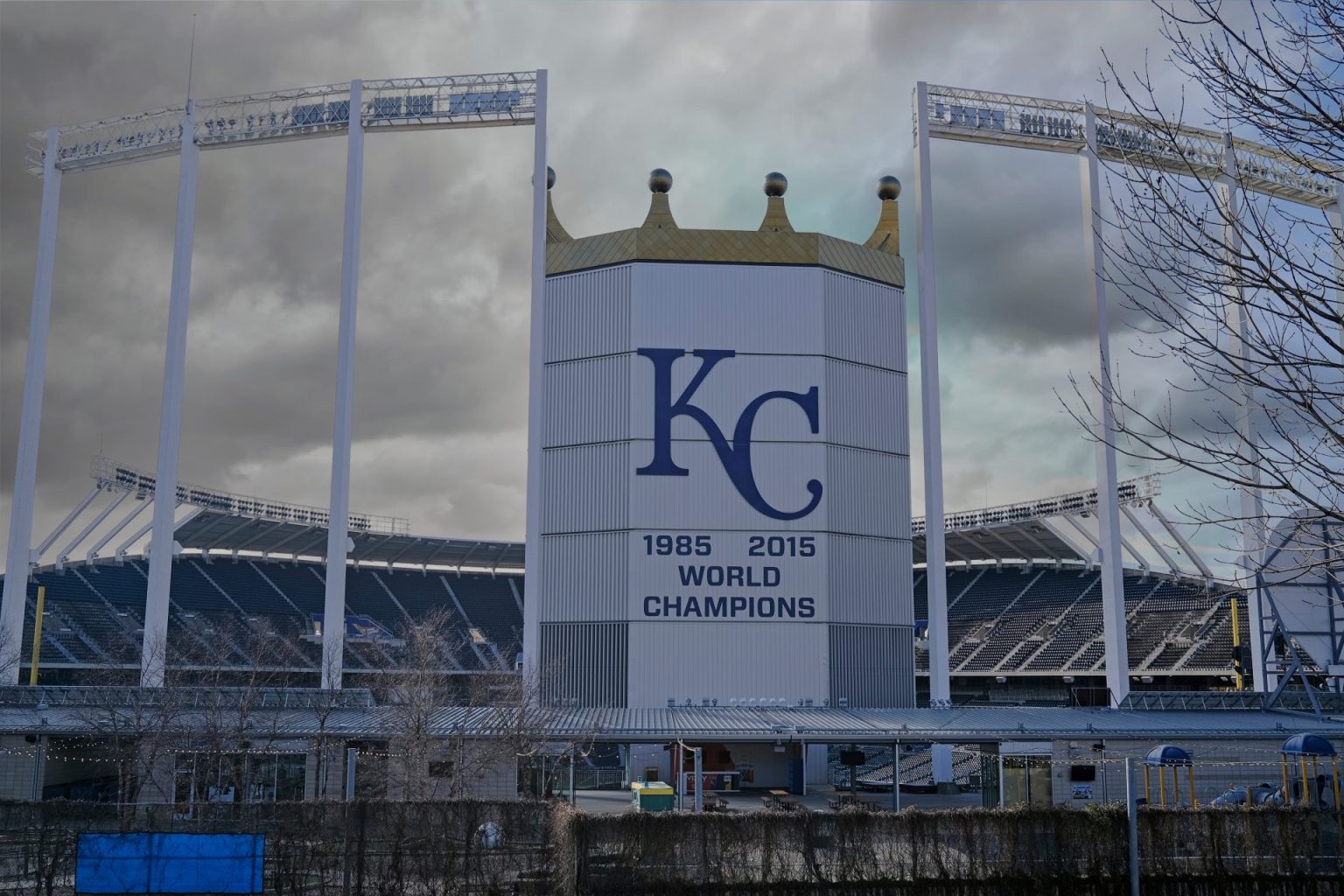Have you ever phoned in a class project so bad, your teacher doesn’t even give you a grade, just a note that says “SEE ME AFTER SCHOOL”?
John Sherman and Clark Hunt might know what that feels like right now.
On Tuesday night, Kansas City-area voters rejected a ballot measure that would have extended an existing three-eighth cent sales tax for another 40 years. That tax would’ve helped pay for a brand spankin’ new downtown stadium for the Royals that they hoped to have built by 2028. On top of that, the Chiefs were fixing to use that tax money to renovate Arrowhead Stadium to the tune of $1 billion.
The measure wasn’t just rejected; 58 percent of voters in Jackson County said “Thanks, but no thanks.”
Fifty-eight percent of voters in a relatively-high turnout election saying ‘no’ may feel like a real head-scratcher, given the Chiefs’ Patrick Mahomes-fueled renaissance and the Royals’ renewed hopes of competing with an MVP-caliber player like Bobby Witt Jr.
But the Vote Yes movement was nothing short of a total bust, despite vastly outspending the opposition, thanks in large part to the leadership of the Chiefs and the Royals themselves.
When the teams first teased their intentions to renovate and expand to locations outside of the Truman Sports Complex back in 2022, I was curious about how they were going to pull off something like moving to downtown Kansas City. The Kansas City Current, the NWSL team, had already planned to build in a location that was relatively untouched, scenic (along the river, at least), and not impossible to get to. That didn’t mean the Royals or the Chiefs couldn’t make something work, but as time went on without any real progress or clarity of plans, I started to question if the teams really knew what they wanted in the first place.
This lack of clarity colored the majority of 2023 for the Royals brass: waffling between multiple possible sites, flaunting the $2 billion price tag, getting into a finger-pointing contest with the county, you name it. All while their team was in the middle of one of their worst seasons in franchise history.
Even after the Jackson County Legislature approved the ballot measure back in January, it took almost a whole calendar month for the Royals to reveal renderings for the downtown ballpark – located in the Crossroads district – and a ballpark village dropping into the location of the old Kansas City Star building.
Various groups like the Sunrise Movement and the KC Tenants brushed back at the idea of using up to $350 million dollars of public money to fund a ballpark plan with an alarmingly low number of details.
The Royals emailed a shady joint letter to Jackson County residents today — its worst threat yet to extort $2 billion dollars from poor and working class communities and funnel it to billionaires. Once again, they’re banking on lies. pic.twitter.com/IcLJboxrqJ
— KC Tenants (@KCTenants) April 2, 2024
It felt like a massive misread of the room by the Royals and Chiefs that they didn’t have a comprehensive plan to make good with the locals, especially with the “using public money for private enterprises” concern that has been gaining a lot of steam over the last few years in markets outside of Kansas City. You’re not going to make everyone happy, but assuming that people would just see the Royals and Chiefs logos and just dropkick their questions, comments and concerns was a total whiff by John Sherman and Clark Hunt.
Speaking of Hunt, we haven’t even gotten to the proposed Arrowhead Stadium plans that look more like an assignment you turned in at midnight after putting it off until 11:30. The stadium was built in 1972 and is currently one of the oldest football stadiums in the NFL. Fixing up that sucker was gonna be pricey, with or without renders of hokey new stadium features.
https://t.co/IYKu2iKpuG pic.twitter.com/mVBfrkaOvs
— Joshua Brisco (@jbbrisco) April 3, 2024
Nothing gets the juices flowing like New Activation Zones, baby.
But, like with the Royals, the reliance on public funds combined with the late announcement on what the big renovations were actually going to look like doomed the Chiefs as well. It also didn’t really help that Chiefs ownership was dealing with their own little PR adventure with their bad grades on the NFLPA report cards.
I’ve already seen and heard plenty of diehard fans lament the vote’s failure. I’ve seen people blame it on Crossroads residents and business owners, so-called ungrateful fans, the mayor of Kansas City (a vocal proponent of the Vote Yes campaign), even left-wing agitators. On some level, I understand it. It’s easier to throw stones at your neighbor than it is to throw them at multibillion dollar franchise owners. Still, what I feel the most towards these angry, resentful Vote Yes fans is pity. They clearly do not like the Crossroads, let alone the city itself or its people. For some, the Chiefs and Royals are probably the only reason they step outside of their neighborhoods at all. They put all their eggs in one gilded basket, and that basket ripped right open at the first sign of friction.
I am not a Jackson County resident; I moved away for college and haven’t lived there since. Even if I was a current resident, I wouldn’t necessarily hate the idea of a sales tax for ballpark benefits as long as the deal was good enough, beyond just the ability to go watch a game close to home. That is not what we got here; we got undercooked ideas leading to undercooked plans. It wouldn’t even be the first time this has happened in Kansas City, if you tracked the trajectory of the former Sprint Center being sold as a potential venue for another professional sports team to being just a glorified concert spot with some basketball action. The seeds of distrust were already there, even if the Royals and Chiefs didn’t see them.
I think the real kicker here is that it didn’t have to be like this. I can’t tell you how many quickie profiles I’ve read of Jackson County voters who love the Chiefs and the Royals and want them to stay, but were bristled by the whole process because of the incompetence of franchise leadership. It should be a slam dunk to get people jazzed about stadium renovations or relocations or anything that guarantees the home team is gonna be sticking around for the foreseeable future. I bet you could have even gotten enough people on board for the Vote Yes campaign to squeak out a victory, despite the recent history of other teams trying to do the same with little to no avail (see: The Arizona Coyotes, The Oakland Athletics). I think the fear of the Chiefs and Royals leaving Kansas City was definitely palpable enough to make it work, especially with Johnson County on the Kansas side actively courting both teams with various earmarked public funds.
As a reminder, when Kansas passed the bill to legalize sports betting, they set aside 80% of the revenue to “attract professional sports teams to Kansas”
This would surely be in tandem with a multi-county sales tax deal, were certain team or two decide to COUGH relocate. pic.twitter.com/9346ECTxt0
— Josh Chavis (@JoshChavis65) April 3, 2024
Kansas City already had a tough shake with Kemper Arena in the 90s, so it’s not like people old enough to remember that fiasco don’t understand the stakes. Ultimately, it’s on the owners to come up with a good enough deal that the fans can and will accept. Too many flaws, too many holes, and too many questions will sink you every time.
I can’t tell you what’s going to happen next. The Chiefs and Royals might go back to the drawing board and come up with another deal for Kansas City taxpayers. They might also just take their balls and go somewhere else that would be more receptive to chipping in public funds to build private stadiums, maybe Kansas, maybe Tennessee, maybe GERMANY, who knows?
The lease for the teams doesn’t end for another few years, so every party involved here has some time to think it over. Hopefully, this leads to owners across MLB and the NFL understanding that just because your fans like you, that doesn’t mean they like being played like suckers. Or, they could have just too much money spilling out their ears to listen. We’ll find out by 2030.

